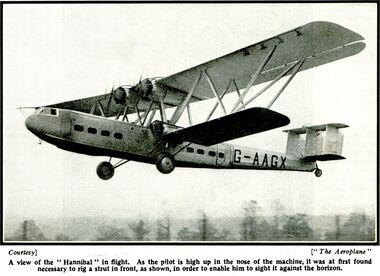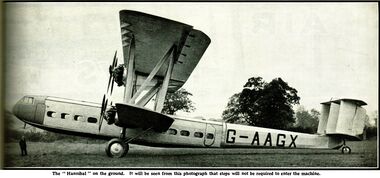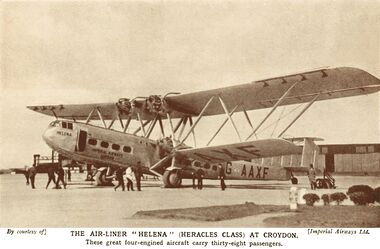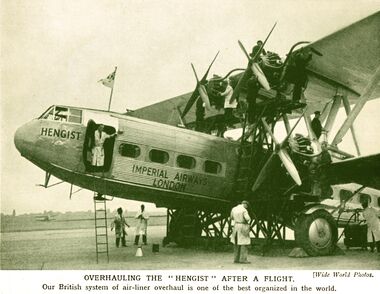Category:Handley Page HP42 Hannibal and Heracles
1931: Hannibal, Hannibal Class [image info]
1931: Hannibal, Hannibal Class [image info]
1934: Hanno, Heracles Class [image info]
1931: Helena, Heracles Class [image info]
1931: Hengist, Heracles Class [image info]
1931: Hannibal Class [image info]
The Handley Page H.P.42 Hannibal, "E" (and HP.45 Heracles, "W") was a distinctive-looking airliner used by Imperial Airways in the 1930s, reckoned to the biggest active airliner in general service, and touted by Imperial as being the latest thing in luxury air travel.
The aircraft's unique look was due to a combination of its ridged silver metal surface, a body that protruded far further forward of the wings than most contemporary aircraft, and a constellation of four engines surrounding the body spread over the biplane wings, two fairly comparatively close together on the top wing, up above the body and two further apart on the lower wing, to either side of the body.
Imperial further enhanced the cult of the H.P.42 by giving all the aircraft names stating with "H".
The two types
The HP.42 was produced in two variants to deal with Imperial's needs, known as the HP42E ("Hannibal" Class) and the HP42W ("Heracles" Class): The long-range "E" version was meant to cover the Eastern routes, and was optimised for the ability to fly over longer distances, while the "W" version was intended for western transatlantic service, and, not needing to fly as far, was optimised for carrying capacity. They were essentially the same aircraft with the same external specifications, the difference being that the longer-range version dedicated more of its capacity to fuel tanks, and gave the passengers more room and baggage, and the shorter-range version (where comfort was less of an issue) instead packed in more seats (38 rather than 24).
The naming presumably referred to Hannibal due to his treks for the long-distance version, and Heracles due to his strength for the shorter-range, heavier-lifting version.
Publicly, the two versions were referred to as the "East" and "West" versions of the HP42: internally at Handley Page, the craft were designated the H.P.42 and H.P.45 .
1934 description:
The "Heracles" and "Hannibal" types, which are also comparatively new are the biggest aeroplanes used by Imperial Airways. The two types are identical in external appearance, being biplanes with four engines, two arranged on the lower wing and two on the upper. The "Heracles," of which there are three in existence, is used on Imperial Airways European services, while the "Hannibal" type, of which there are five, was built for the Africa and India services. The European type has accommodation for 38 passengers in two cabins, while that intended for service in the East carries only 24 passengers, owing to the fact that more room is necessary for comfort in tropical countries.
In the design of the "Heracles" and "Hannibal" types close attention has been paid to the provision of comfortable accommodation for passengers. The position of the fuselage is in itself evidence of the care and thought that has been expended in this direction, for it is situated below the planes in order to reduce engine noise in the cabin. Placing the cabin in this position also provides passengers with an uninterrupted view downward and outward, and alleviates the tendency to air-sickness of those who have not become accustomed to travelling by air. Another device that helps to reduce the noise in the saloons is the provision of a rapid metal cover that eliminates noise due to the flapping of fabric. The space between the cover and the interior decorations also is padded with sound-insulated material, and the floor is covered with carpet.
The saloons are normally warmed by hot air drawn from an engine exhaust muff, and in order to prevent the entrance of oily vapours with it the air supply is taken from a point in the leading edge of the upper plane. Before reaching the saloon it passes through a regulator in which cold air can be added in order to attain any desired temperature. The control for this is placed in the corridor between the saloon and the buffet.
The efficiency of the ventilation is also a feature of the machines. Fresh air taken from the outside of the centre slip-stream is led by pipes to the tubular members of the light luggage racks in the cabins, and diffused from these into the saloon through slots. When necessary this air can be warmed by introducing into it a part of the supply of hot air. A special regulating valve for this purpose is placed near the main hot air valve and local control is provided by means of valves fitted alongside the seats An independent supply of fresh air is obtained from large adjustable intakes situated aft of the pilot's cabin and this is led through semi-circular ducts arranged in the roof of each one of the saloons.
Machines of the "Heracles" and "Hannibal" types weigh 13.4 tons when fully loaded and are capable of flying at a speed of 130 mph. The upper plane of each type of machine has a span of 130 feet and a chord of 16 feet 6 inches, and the span of the lower plane is 94 feet and it has a chord of 11 feet 6 inches.
The overall length is 86 feet 6 inches and the height with tail down is 25 feet. The wheel track is 28 feet 2 inches in width. The "Hannibals" make use of four Bristol "Jupiter" XF MB type engines, each of which develops each of 555 h.p., while machines of the "Heracles" type use "Jupiters" of the XI F type.
— , -, , Meccano Magazine, , November 1934
Pages in category ‘Handley Page HP42 Hannibal and Heracles’
The following 3 pages are in this category, out of 3 total.
Media in category ‘Handley Page HP42 Hannibal and Heracles’
The following 10 files are in this category, out of 10 total.
- Handley Page 42, Card No 31 (GPAviation 1938).jpg 2,400 × 1,254; 342 KB
- Handley Page Hannibal G-AAGX, Imperial Airways (MM 1931-04).jpg 3,000 × 2,176; 973 KB
- Handley Page Hannibal G-AAGX, side view, Imperial Airways (MM 1931-04).jpg 3,000 × 1,406; 920 KB
- Handley Page Heracles, Card No 14 (JPAeroplanes 1935).jpg 3,000 × 1,529; 606 KB
- Hanno, HP-42 Heracles-Class G-AAUD (WBoA 8ed 1934).jpg 3,000 × 2,212; 927 KB
- Helena, HP-42 Heracles-Class G-AAXF (WBoA 8ed 1934).jpg 3,000 × 1,966; 796 KB
- Hengist, HP-42 Heracles-Class airliner G-AAXE, Imperial Airways (WBoA 8ed 1934).jpg 3,000 × 2,173; 986 KB
- Hengist, HP-42 Heracles-Class G-AAXE (WBoA 8ed 1934).jpg 3,000 × 2,321; 1.08 MB
- Heracles biplane airliner G-AAXC.jpg 1,800 × 1,200; 1,023 KB
- Wonder Book of Aircraft, Imperial Airways (WBoA 6ed 1928).jpg 2,253 × 3,000; 1.78 MB

















